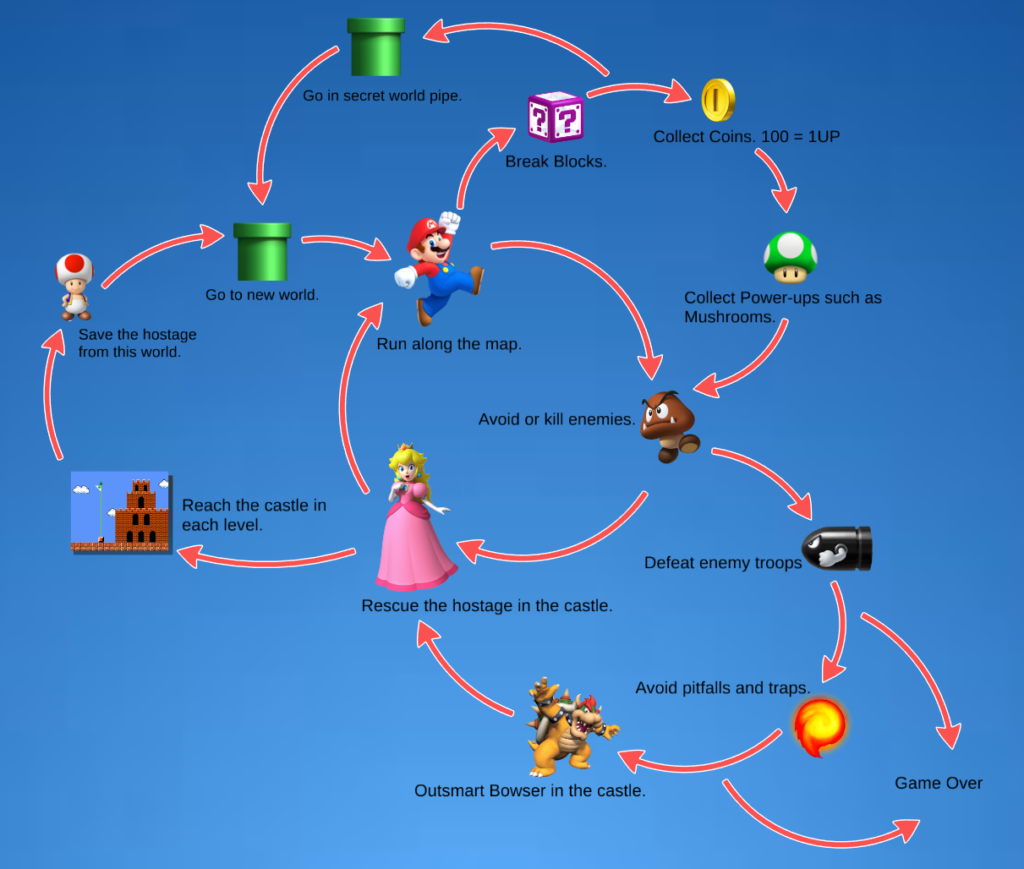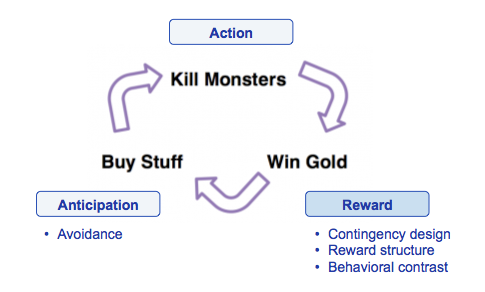What exactly is it?
A core loop is one of the most important parts of game design, especially in F2P production.
It is what people think of when you ask them about the game. It might be one level in Candy Crush Saga, one session of Clash of Clans, one mission in Battlefield or a single deathmatch in Team Fortress 2. The core loop is the basic thing that the player does over and over again. The proper reaction when you show it to someone is “Ok, nice, now I understand your game.”
The thing is, though, they don’t. They only understand the core of the game, but there is much more to it than just that. While this may sound simple, many developers have failed because they couldn’t figure this out or just didn’t want to waste time on this. The core loop should explain the main goal of the game. It is usually presented graphically, with a description above or below. Sometimes a loop will be so perfect that players keep coming back to the game a few times a day. In F2P development this is a particularly important matter because it improves retention, which is one of the most significant things in monetization. The basic core loop should show, in a simple manner, the main actions that users have to do in order to gain rewards and expand their characters.

Source: Dejan Zuza, Improve your game: Core loop
Why is it so important?
Here we have to ask ourselves:
Can we build a game without a core loop? Probably.
But can we build an excellent game, with a great economy, that will turn into a great product and achieve sales success? Probably not.
As mentioned earlier, the core loop is one of the most important parts of game production. It is the skeleton on which all the mechanics, logic, and economy of the game are built. As is easy to guess, without a skeleton it would be hard to keep the whole body from falling apart. Some game designers argue that the best core loops are based on real-world activities. There is truth to that. A Core Loop helps to determine what the game is about and define and clearly explain its mechanics
In fact, if we can’t make a core loop, it means that we don’t know what our game is about.
Core Loop Types
There are several types of core loops. Mostly, which type we choose depends on how detailed we want the description of the game to be and how we look at it. The truth is, we can’t define the whole game with one loop; it is simply not possible. For this purpose, the game loop categories have been created.
We distinguish 4 types of game loops.
1. Main Loop
Main Loop is a general description of the game. It mainly shows us the direction of the game and what the player will be dealing with. Loop should be constructed that the regular player can tell what he will do in the game, without spreading mechanics down. The person after reading the main loop should know what are the basic resources of the game, on what rules game is based, what can be done to achieve the goal of the game and what will prevent it. That’s it. Very often we use this type of loop for pitching our game.

Source: Mobile Free to Play: The Free to Play Game Design Bible: Crafting a Strong Core Loop
Brawl Stars – Core Loop Deconstruction
In this example, we will deconstruct the Brawl Stars. The game shows us how the basic, general game goes. First, we enter the game, we fight with other players, which is why we lose our time, but we gain “Coins”, “Account Experience” and we have the opportunity to gain or lose “Hero Trophies”. The next step is to improve our character and items. At this stage, we can see that we are losing “Elixir” but we are increasing the maximum value of the “Health” and “Attack” resource. The next step is to open a loot box. We’re losing coins, but we get new “Heroes” and “Elixir”, which we previously spent on improving “Heroes”. And we return to the starting point. As you can see, in a few pictures you can describe the whole game flow without going into detail.
2. Dual Loop
A dual loop allows players to either stop their session after the first loop or continue playing through both of the loops, extending their session. This loop is used very often for games that consist of farming resources expanding a given instance; mostly strategic games. The dual loop is not a subcategory of other game loops; it is considered to be one of the core loops. Depending on the type of game, either the dual loop or the main loop is used as the source of the game’s description.

Source: Kevin Wolstenholme, What is a Core Loop in a Mobile Game?
Clash of Clans: Core Loop Deconstruction
In this case, we will deconstruct one of the most recognizable mobile games: Clash of Clans. At the beginning we can see the acquisition of resources: We acquire “Gold” and “Elixir” by producing it in real-time in our factories. Then we either go to fight or we build and level up our character (in this case: the City). If we fight with the NPC, we gain “Gold” and “Ranking Points”, but we lose “Elixir”. However, instead of immediately fighting, we can first train our military units and improve our city equipment. As a result, we get rid of the resources “Gold” and “Elixir”. Then, going back to the beginning, we can either collect resources and spend them on improving ourselves, or go to fight again. Thus we have described a game that never ends. This is a very general overview; as inside this loop, there is another dozen, or several dozens of loops that create game content.
3. Nested Loop
Nested loop is a programming term which refers to putting a loop inside another loop. In this case, it almost looks like a well-made loop. The distinguishing factor is that loops have set finish points before they begin and the player doesn’t have to finish one loop before starting another. For example, the player can jump on a brick and at the same time use a spell or a simple attack. In preparing a nested loop we should describe each of the tiniest elements of the game, including how the input/output works, player movement and behavior. A programmer looking at it should be able to understand the logic of the game and immediately start working on the project. This loop should contain several loops inside. Game designers usually implement a game loop into a nested loop, creating a loop that shows the whole game step by step.

Source: Ethan Stanaway, Super Mario Bros: Core Game Loops and Reward Structures
Mario: Core Loop Deconstruction
In this case, the Mario loop shows us the player’s goal and journey, as well as the system’s response to the player’s behavior. However, it lacks accuracy, and there’s no breakdown into smaller elements and no description of the game’s economy.
4. Compulsion Loop
“A habitual, designed chain of activities that will be repeated to gain a neurochemical reward: a feeling of pleasure and/or a relief from pain.” – Joseph Kim, Gamasutra.com

Source: Mobile Free to Play: The Free to Play Game Design Bible: Crafting a Strong Core Loop
In this kind of loop, we focus on the psychological aspect of playing games. The mechanics are described in terms of a player’s mind. The purpose of the loop is to create a constantly repeated habit, such as looting your enemies. This loop should include a set of specifically designed activities within each step in the chain. In this case, the loop shows us how we can get the player addicted to the game with carefully planned mechanics: using the psychological desire to amass and improve your equipment, we lead the player into the compulsion loop. Our only goal now is to make sure that the player stays in it as long as possible, which means we now have to think about the next set mechanics and psychological tricks.
How can you achieve a good core loop?
Game designers often ask themselves how to make a good loop. Here is an exercise: try to pretend to be an investor, a programmer, and a grandmother. This will reveal the different perspectives. Each of these characters has an important role to play, I promise. The investor should understand the game but most importantly notice its sales potential. The programmer should know what the game is about, but mainly understand the logic of the game and how to build it. And the grandmother? Grandma has to demonstrate that the game’s mechanics are based on real-world activities, as she will be trying to find out exactly what is going on in the game, and she will keep asking her grandson (You!) to explain it to her.
A more serious answer to this question, however, is to first plan your game, and then break it down to its basic parts, so that you are forced to analyse every possible aspect of the game. It always starts the same way: at the beginning, we don’t really know what to write. We have this idea for a game, but we can’t really summarize it well. So we start to write or draw or visualize in some other way what we have in our heads. We get to the point where we think we have written the game. But this is a very false and misleading impression! At this stage we must remember that practically no game can be described in several pages.
Then we start from the beginning. This is called iteration. We come to the point where we have already written the mechanics, e.g. what the player’s movement should look like, although we can very rarely describe it in detail without iterating. We usually get to a point where we have already done this, and then we start from the beginning, but now we have in mind more details about our game , more thought-out options and game mechanics, and above all, the skeleton of our mechanics. And so we encapsulate the skeleton until the whole body is created.

Source: John Haag, Pokémon Go: A Teardown
In my opinion, a well-made loop is when you read it and ask yourself this question: … Right. There should be no questions.
A perfectly done economy core loop contains:
- main goal
- minor goal
- basic mechanics
- basic game economy
Psychological aspect
The core loop is not only about numbers, mechanics and logic. It is also about how to keep the player for longer, how to make the player think every minute of the game how in 2 hours he will be telling his friends what a great game he played. How do you do it so that the player can feel the satisfaction of the game all the time? The psychological aspect is here to help.
Scientists say that the player’s expectations and desires are programmable.
Showing them from the very beginning what is most important and what is less important programmes the player’s mind. From now on, when the player sees diamonds instead of the usual silver coin, dopamine in the brain will start coursing through their body. They feel excited and a smile appears on their face. The right amount can even lead to sounds being produced.
Influencing the player’s psychology is an incredibly important aspect of building the flow of the game. These are the so-called instant reward mechanics.
The player will not be aware of what is happening in his brain, but the whole game is programming his mind every second. Even rest can constitute a reward. If we have energy resources in the game, through which the player can run, we can renew the whole energy bar by walking slower for some time. There are hundreds of such hidden mechanisms.
When planning the psychological aspect of the game, remember to not stifle your creativity in creating the mechanics. The sky’s the limit.

Not only for games
Last but not least! Core loops can be used not only in games, but in apps too. These loops can even describe our lives. Such a loop is just a tool for writing down the logic of anything. For example, the human life loop would look like this: we are born, we grow up, we learn and study, then we go to work, then we learn and study again, then we change jobs all the time, until we finally leave this loop, which is what we call death. Our whole world is one big loop.
A perfect example would also be Starbucks.
We can see here what the path looks like in this popular coffeehouse.
First we buy coffee, but we also get points and discounts for the next coffee, which contributes to our purchase of another coffee, and this is how our coffee adventure becomes a loop.
Source: Robbie Allen, Core Loop: The Must Have Feature for Every Mobile App
Of course, let’s not go from one extreme to another. Coffee can defend itself and we do not owe everything to these psychological tricks. And so must we do in games. Sometimes a very good game can defend itself, but sooner or later the developers will have to improve it anyway and without logical deconstruction – there is no such possibility.
Depending on how the application is constructed, loops can be simple or more complicated.
Summary
Core Loop is one of the most important things in game development.
If you’ve never done it, it’s time to start creating core loops and make your and your team’s lives easier.
Thanks for your time!

